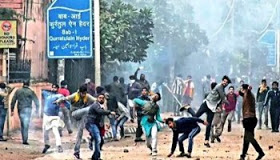By: Prof. Pradeep Mathur
NEW DELHI: Last week’s communal riots in Delhi deeply pained all sensible and right-thinking people. The loss of human lives and property has been shocking beyond words. Every such incidence of rioting makes me feel professionally guilty for a strange reason. How I wish I had managed time and resources to do a book I had planned to write on this subject in mid 1980s. I had drawn an outline of the book, collected some material and had even decided on its name –The Riot Industry. However, writing this book remained an idea like that of many other professional projects which I conceived but could not deliver.
Though I covered Union Home Ministry as a Special Correspondent ,in my rather long career in active journalism I never worked as a crime reporter and writing on law and order was never part of my reporting beat. The idea to do a book on rioting came just by chance. I was Resident Editor of The Pioneer and one afternoon a young office worker aspiring to be a media writer came to see me. He had done an average piece on some aspect of life in Varanasi and wanted me to publish it in The Pioneer.At one point during our discussion he said there could be communal trouble in Varanasi after two days.
I did not say anything to him but after he had left I called our Chief Reporter Fakhruddin Hatimbhoy and asked him to check up with police authorities. Police had no inkling of any communal trouble and after checking up with local intelligence unit they dismissed this talk of a riot as a figment of somebody’s imagination.
However, after two days a communal clash did take place. A group of six-seven young boys threw stones at a mosque in Madanpura area from the other side of the road and there was retaliation from the other side. Since it was Saraswati Puja time there was police patrolling all over the city. The police immediately reached the trouble spot, chased away the stone throwers and saved the situation from developing into a full-scale communal riot.
In The Pioneer newsroom I and my team of young reporters felt mystified. How a casual visitor could know about a communal tension built-up which neither the district and police authorities sensed nor the city reporters had any inkling about.
Since the visitor had left his phone number I called him to my office on the pretext of discussing his piece. I asked him how could he know about the communal clash before- hand. And his answer shocked me.
He said for some construct work in his house he had gone to buy bricks . There he saw two people shopping for small pieces of broken bricks and wanted these to be delivered late in the evening on road side before a mosque. He said he thought that these could only be for throwing at the mosque and that is what he had told me.
Our reporters followed the lead. The brick stones were delivered after 8 pm when there was almost no traffic on the road. No construction work was being done near the site of delivery point and the quantity of material delivered was too little for any meaningful construction activity.
The pressure of newspaper journalism did not give my skeleton editorial staff time to chase the story further. But we understood two points very clearly. One the riots are pre-planned and the other that planning a riot costs money. Since some one is putting money in this risky business he must also be sure about returns on his investment.
Unknown to most of us, riots are a lucrative business which are organized with a profit motive. Only thing is that the business man never comes in the open and his “employees”, who work as volunteers , get the wages of death and destruction. Since violence for a longer period hurts business market, riots have a very short life term.
(The author, a veteran journalist and a former Professor at IIMC, New Delhi, is editor of Media map, a monthly thought journal on current affairs & Sr. Consulting Editor-ICN Group)




